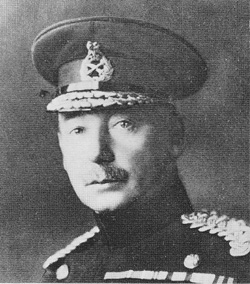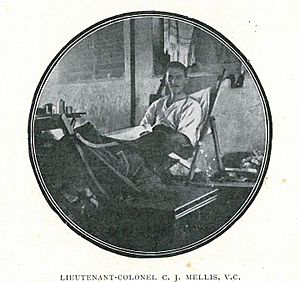Charles Melliss facts for kids
Quick facts for kids
Sir Charles John Melliss
|
|
|---|---|
 |
|
| Born | 12 September 1862 Mhow, British India |
| Died | 6 June 1936 (aged 73) Brockenhurst, Kent, England |
| Buried |
St. Peter's Churchyard, Frimley, Surrey
|
| Allegiance | United Kingdom |
| Service/ |
British Indian Army |
| Rank | Major General |
| Unit | Indian Staff Corps |
| Commands held | 53rd Sikhs (1906–10) |
| Battles/wars | Tirah Campaign War of the Golden Stool First World War |
| Awards | Victoria Cross Knight Commander of the Order of the Bath Knight Commander of the Order of St Michael and St George Order of the Brilliant Star of Zanzibar Croix de guerre (France) |
Major General Sir Charles John Melliss (12 September 1862 – 6 June 1936) was a brave British Army officer. He lived in the late 1800s and early 1900s. He received the Victoria Cross, which is the highest award for bravery in the face of the enemy. This award is given to British and Commonwealth soldiers. During the First World War, he was a staff officer in the Mesopotamian Campaign. He was captured by enemy forces after the Siege of Kut.
Contents
Early Life and Start in the Army
Charles John Melliss was born in Mhow, British India, on September 12, 1862. His father, George Julius Melliss, was also a Lieutenant General in the Indian Staff Corps.
Charles went to school at Wellington College, Berkshire. Then he attended the Royal Military College, Sandhurst. In September 1882, he officially joined the East Yorkshire Regiment as an officer.
Military Adventures
In 1884, Melliss joined the Indian Army. He served in East Africa from 1895 to 1896. He also worked on the North-West Frontier of India from 1897 to 1898. Later, he was part of operations in the Kurram Valley in Tirah during 1897–98.
He then served in West Africa with the North Nigeria Regiment from 1898 to 1902. This included fighting in Ashanti in 1900. He helped during the relief of Kumassi in the War of the Golden Stool. During these missions, he was wounded four times. One of these injuries was very serious.
Winning the Victoria Cross
Charles Melliss earned the Victoria Cross for his actions in Ashanti. This happened while he was with the West African Frontier Force. On September 30, 1900, at a place called Obassa, Captain Melliss showed amazing courage. He gathered a group of soldiers and led them into the thick enemy lines. Even though he was wounded in a close-up fight, his bold charge made the enemy panic. At the same time, Sikh soldiers also charged, helping to defeat the enemy.
Melliss was promoted to major on July 10, 1901. For his bravery that won him the Victoria Cross, he was also given the special rank of brevet lieutenant colonel the very next day. He left his role as second-in-command of the Northern Nigeria Forces in late 1902. He then returned to the Indian army and joined the 1st Bombay Grenadiers.
His regiment served in East Africa from 1902 to 1904. In 1903, he had a dangerous encounter and was badly injured by a lion. He commanded the 53rd Sikhs (Frontier Force) from 1906 to 1910. He also took part in operations on the North West Frontier in 1908. On March 19, 1912, he was promoted to major general.
First World War and Capture
When the First World War began, Major General Melliss joined the 6th (Poona) Division of the British Indian Army. This division moved into what was then the Ottoman province of Basra in 1914. In April 1915, he played a key role in the British victory at the Battle of Shaiba. Melliss also fought in the Battle of Ctesiphon. This was the furthest the 6th Division went up the Tigris River.
After the Battle of Ctesiphon, General Townshend, who commanded the 6th Division, ordered a retreat. They went back down the Tigris River. Ottoman forces chased them to Kut-al-Amara. On December 7, 1915, General Townshend told his troops to dig in and wait for help.
During this siege, Melliss became ill. He was in the hospital when General Townshend surrendered on April 29, 1916.
Life as a Prisoner of War
Melliss was taken by steamship upriver to Baghdad. He stayed in the hospital there because he was too sick to travel. The other captured soldiers of the 6th Division were marched north towards Anatolia.
When Melliss was well enough, he followed the same route north. Because he was a general, he was allowed a small group of helpers and better supplies. Along the way, he saw many British and Indian prisoners who had died or were dying. They had fallen behind the marching columns. Melliss took any survivors he found with him. At each stop, he insisted that these rescued men be put into a hospital.
Melliss spent his time as a prisoner in Broussa, in northwestern Anatolia. While there, he wrote many letters to Enver Pasha, an Ottoman leader. He described the terrible condition of the captured soldiers. He demanded that they receive better treatment. Sadly, most of the British soldiers (1,755 out of 2,592) captured at Kut-al-Amara died while in captivity.
Later Life and Legacy
Sir Charles John Melliss retired from the Indian Army on February 24, 1920. On May 31, 1921, he was appointed Colonel of his old regiment, the 53rd Sikhs, Frontier Force. He held this position until November 1934.
He is buried at St. Peter's Churchyard in Frimley, Surrey, England. His Victoria Cross medal is kept at Wellington College.
Family
In 1901, Charles Melliss married Kathleen Walker. She was the youngest daughter of General J. M. Walker.


